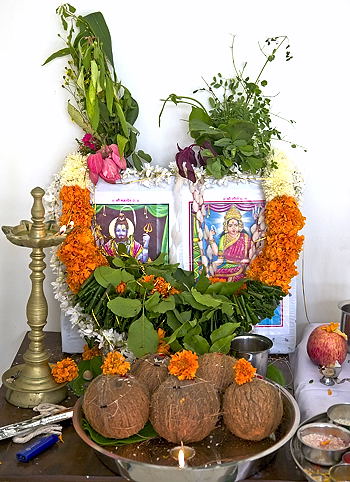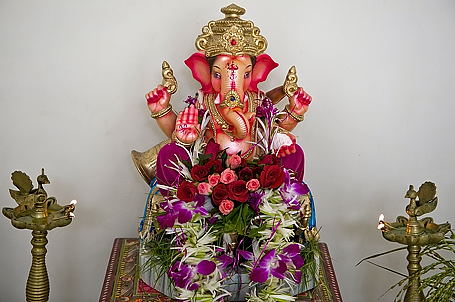
Ugadi Pooja Neivedyam



Sri Sarvadhari naama Ugadi/Gudi Padwa Shubhakankshalu!
(I thank my father-in-law for the beautiful picture of Parimala Prasadam.)
Bhukthi means nourishment. While nutritious food is needed to sustain us for everyday activities and the maintenance of this physical body, a different kind of Bhukthi is necessary to satisfy our cravings to realize the true happiness in ourselves. Constant indulgence in the name of God (Bhakthi) provides the nourishment to realize the bliss of boundless divinity in the ego-limited humans.
This relation between Bhakthi and Bhukthi thus goes deep and this concept is brought to the people in beautiful poetry and song by many saint musicians of India.
Saint Purandara Dasa, the father of Carnatic music has created song and music the way to achieve the happiness which we all seek. He has composed innumerable songs called keerthana’s, full of wisdom and devotion eternalized in the hearts of people. His message of morals is handed out in easily understandable form, woven together with stories from the epics, along with beautiful expressions and analogies. No wonder his songs have pleased, inspired and guided people since more than four hundred years.

God is the source for infinite happiness and he has infinite names, infinite forms and is ubiquitous. For Purandara Dasa, God is Purandara Vittala in whose form he saw all other manifestations or avatars of God like Rama, Krishna, Shiva and Hanuma.
The spiritual song “Rama nama payasakke” is quite popular and sung by many in their own versions. It was written in the beautiful south Indian language of Kannada which is said to be as enchanting as the fragrance of kasturi. Saint Purandara Dasa elicits the great bliss in chanting the name of the God Vittala in “Rama Nama Payasakke“.
The keerthana explains with an easy analogy on how to obtain the spiritual bliss or Ananda with a recipe to make payasam.
The keerthana goes like this:
Pallavi: rAma nAma pAyasakke krSNa nAma sakkare viTTala nAma tuppava kalasi bAya capparisiro
Charana1: ommAna gOdiya tandu vairAgya kallali bIsi summane sajjige tegadu kammana shAvige hosedu
Charana2: hrdayavembo maDikeyalli bhAvavembo esaraniTTu buddhiyinda pAka mADi harivANake baDisikoNDu
Charana3: Ananda Anandavembo tEgu bandidu kaNIrO Ananda mUruti namma purandara viTTalana neneyiro
Purandara Dasa sings, “O people, indulge in the lip-smacking-good payasam called Rama nama, which is made sweet with the sugar called Krishna nama and is richly folded with the ghee called Vittala nama”Â.
Then he describes the meticulous details needed to make this special payasam from the scratch.
First obtain wheat flour of honor. Grind it in the mill of detachment. Make the dough called simplicity and draw thin semiya noodles from it.
In the pot called your heart, boil the noodles with the milk of feelings. Cook it then with the wisdom of worship.
Add the sweetness of Krishna’s name as sugar, and the nourishing richness of Vittala’s name as the ghee and lo you have your lip-smacking-delicious payasam.
Purandara Dasa even describes the proper method to enjoy the delicious payasam. He beckons us to serve it on a large platter and enjoy it. When burps emanate out of fulfillment, he asks us to remember the name of God Vittala who is the embodiment of immeasurable happiness and ecstasy.
Through this keerthana, purandara dasa gave us a recipe to live an ideal life. To live our life with honor, come through the grinds of materialistic attachments with austerity, and obtain the raw material for happiness using the simple method of devotion. Allow the feelings of joy and love boil in our heart wisely, and celebrate every moment of our life bit by bit contemplating God’s grace with gratitude. That is the ultimate sweet bliss!
Makara Sankranthi Shubhakankshalu!


Article Contributed by Madhuri Akkenepalli (Friend of Mahanandi)
Photos by Indira Singari
Previously on Rakthi Raga for Bhukthi:
Of Being and Becoming ~ Ragi Idlies by Janani Srinivasan
Links:
Saint Purandara Dasa on Wiki.
Audio Links to “Rama Nama Payasakke”:
by Sreemathi Sudha Raghunathan and Vijayalakshmi Subrahmaniam
This year we celebrated Ganesh Chaturthi in Goa. Tourists come to Goa in hordes to enjoy Christmas and New Year’s Day, but fortunately, Ganesh Chaturthi here has remained a quiet, joyous festival that graces the home and the temple rather than strut the streets. Having grown up on the very public, loud, and grandiose observances in Mumbai, the Goan experience came to me with all the freshness and fragrance of a monsoon breeze. Here there are no gigantic idols worth crores of rupees, no loudspeakers blaring crude film songs, no vargaNi (monetary donations) demands at your door by Ganeshotsav associations, and none of the other attendant evils of commercialized celebrations. While there are saarvajanik (public) Ganesh utsav celebrations in Goa, the scale and noise is nowhere near that of Mumbai. The spirit of Ganesh Chaturthi – a celebration of the birth of Ganesh through private worship, cooking and eating delicious saatvik meals, visiting your friends’ and neighbours’ and sharing festival snacks, participating in the aarti, community events such as cooking contests, rangoli and maaToLi competitions – is still alive in Goa.
Here are some vignettes from our Ganesh Chaturthi in Goa.










Photo Credits: Rajan Parrikar


Shri Krishna Janmashtami Subhakankshalu!
Thank you Yasin bhai for sending the delicious jilebi for us!
One of the places we visit whenever life overwhelms us here in US is the New Vrindaban Holy Dham. Located in beautiful and peaceful Appalachian mountain range in the rural West Virginia panhandle, in almost 500 acres, the place is serene and ideal for meditation and contemplation.
The main attraction for us is Radha Krishna temple, and then there is Palace of Gold – Sri Prabupada’s place. There are also small lakes, ponds, swans, peacocks and cows on the ground. To volunteer there is a cow-protection program, community organic vegetable garden and a fragrant rose garden. The temple also has decent cottages and rooms to rent, and they book up fast during summer times. Families with children and with old parents from India often come to this place to escape the everyday hustle and bustle. Though the drive to the place is like a thrill ride with sharp curves and 25 mph speed limit, the place is spectacular and spiritual. Even with all the difficulties of money shortage etc. for the temple, I am glad to see such a beautiful place existing in America for us to visit and to rejuvenate.
Here are some photos that I have taken during our recent trip to this temple as part of my bhakti~bhukti (divine and dine) series. Photos include temple and temple grounds along with Krishna prasadam (temple tradition – After the afternoon puja everyday, a full satvik meal is served in generous portions to the visitors, free of charge.)










New Vrindaban – Homepage
Bhakti ~ Bhukti (Divine and Dine) – Sri Venkateswara Temple, Pittsburgh

Temple food is the best way to enjoy traditional Indian food and no restaurant can match the taste and the quality. In Pittsburgh, the SV Temple canteen is open during temple hours and has a small kitchen and big dining hall to the side. The food is freshly prepared daily by the temple chef. The standard items you would find are – pulihora, yogurt rice, sambar rice, upma, pongal, mixture: sweet&hot varieties and also pickles. There is also a machine, where you can make your own tea and coffee.
The canteen has a separate entrance and open to all. Everything is priced very reasonable ($1.50, a box). My favorites are pongal, upma and mixture and I always buy them whenever I visit temple. Because of recent increase in number of people visiting this temple, temple management is fund-raising to build a more modern and big kitchen and also planning to include more items to serve.
Summer is the travel season here in US and temples are the most common tourist destinations to lot of folks like us. Our visits to temple are not only for divine darshan and also for homely dining. So thought I would share about SV Temple food. Bhakthi and bukthi fulfilled at the same time.


Bhakthi & Bhukthi – For Summer Travel:
Do you have a temple in your town/city? Join and share “Bhakthi and Bukthi” (divine and dine), experience, if you are interested, at your blogs. Thanks!
Temple Food: Ganesha Temple, Flushing, NY